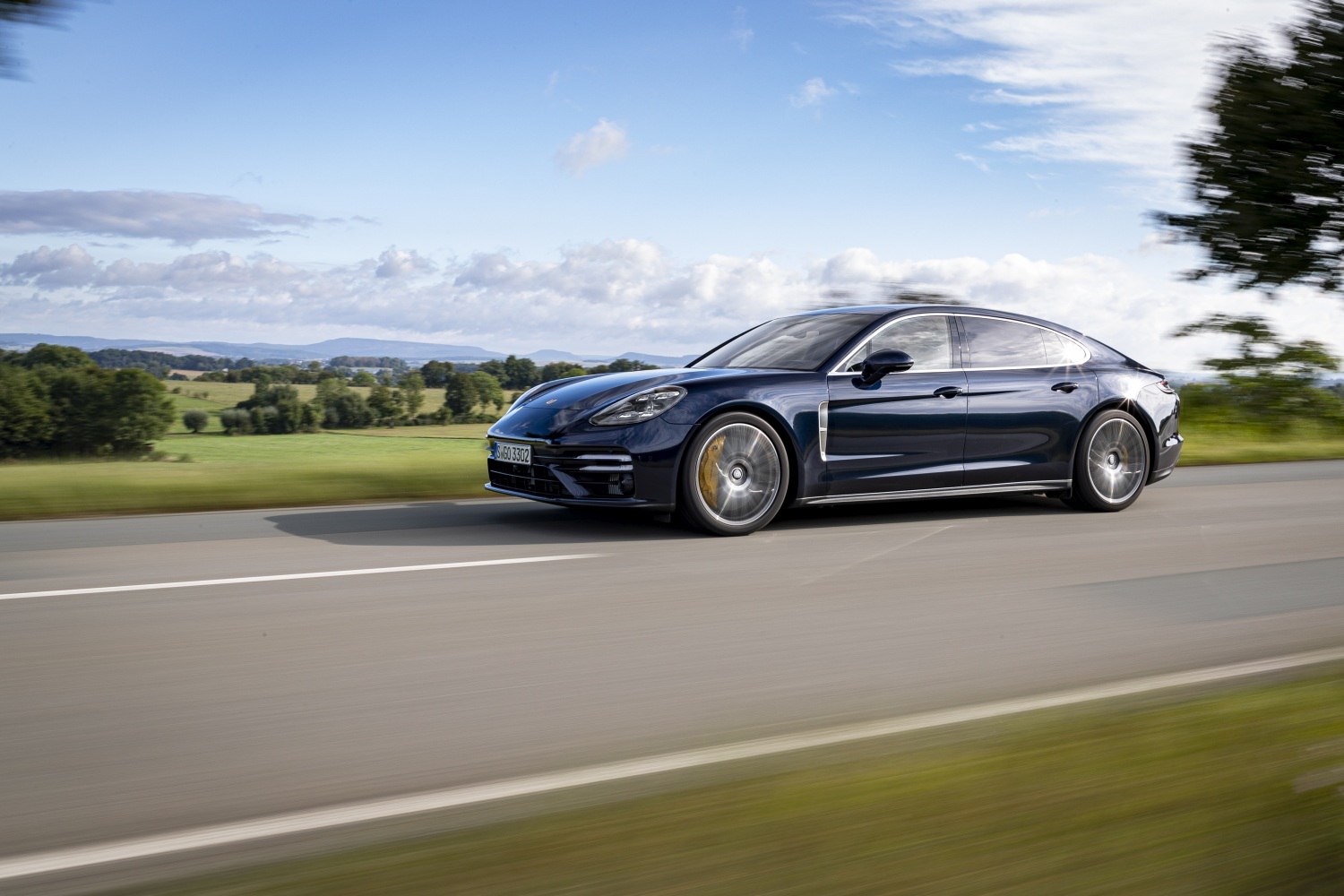2020 Porsche Panamera (G2 II) Executive Turbo S 4.0 V8 (630 Hp) PDK | Dane techniczne




















































| Drag coefficient (Cd) | 0.29 |
| Front track | 1657 mm |
| Height | 1432 mm |
| Length | 5199 mm |
| Minimum turning circle (turning diameter) | 11.8 m |
| Rear (Back) track | 1637 mm |
| Wheelbase | 3100 mm |
| Width | 1937 mm |
| Width including mirrors | 2165 mm |
Space, Volume and weights
| Fuel tank capacity | 90 l |
| Kerb Weight | 2185 kg |
| Max load | 450 kg |
| Max. roof load | 75 kg |
| Max. weight | 2635 kg |
| Permitted towbar download | 100 kg |
| Trunk (boot) space - maximum | 1455 l |
| Trunk (boot) space - minimum | 467 l |
Drivetrain, brakes and suspension specs
| Assisting systems | ABS (Anti-lock braking system) |
| Drive wheel | All wheel drive (4x4) |
| Drivetrain Architecture | The Internal combustion engine (ICE) drives permanently the four wheels of the vehicle. |
| Front brakes | Ventilated discs, 420x40 mm |
| Front suspension | Double wishbone |
| Number of gears and type of gearbox | 8 gears, automatic transmission PDK |
| Power steering | Electric Steering |
| Rear brakes | Ventilated discs, 410x32 mm |
| Rear suspension | Independent multi-link suspension |
| Steering type | Steering rack and pinion |
| Tires size | Front wheel tires: 275/35 ZR 21Rear wheel tires: 325/30 ZR 21 |
| Wheel rims size | Front wheel rims: 9.5 J x 21Rear wheel rims: 11.5 J x 21 |
Engine specs
| Compression ratio | 9.7:1 |
| Cylinder Bore | 86 mm |
| Engine Model/Code | EA825 / MCV.DA |
| Engine aspiration | BiTurbo, Intercooler |
| Engine configuration | V-engine |
| Engine displacement | 3996 cm3 |
| Engine layout | Front, Longitudinal |
| Engine oil capacity | 9.5 l |
| Engine systems | Start & Stop SystemParticulate filter |
| Fuel injection system | Direct injection |
| Maximum engine speed | 6800 rpm. |
| Number of cylinders | 8 |
| Number of valves per cylinder | 4 |
| Piston Stroke | 86 mm |
| Power | 630 Hp @ 6000 rpm. |
| Power per litre | 157.7 Hp/l |
| Torque | 820 Nm @ 2300-4500 rpm. |
General information
| Body type | Liftback |
| Brand | Porsche |
| Doors | 5 |
| End of production | 2023 year |
| Generation | Panamera (G2 II) Executive |
| Model | Panamera |
| Modification (Engine) | Turbo S 4.0 V8 (630 Hp) PDK |
| Powertrain Architecture | Internal Combustion engine |
| Seats | 4 |
| Start of production | 2020 year |
Performance specs
| Acceleration 0 - 100 km/h | 3.2 sec |
| Acceleration 0 - 200 km/h | 11.5 sec |
| Acceleration 0 - 60 mph | 3.0 sec |
| Acceleration 0 - 62 mph | 3.2 sec |
| CO2 emissions | 249-251 g/km |
| Emission standard | Euro 6d-ISC-FCM |
| Fuel Type | Petrol (Gasoline) |
| Fuel consumption (economy) - combined | 10.9-11.0 l/100 km |
| Fuel consumption (economy) - extra urban | 8.5-8.7 l/100 km |
| Fuel consumption (economy) - urban | 15.0-15.1 l/100 km |
| Maximum speed | 315 km/h |
| Weight-to-power ratio | 3.5 kg/Hp, 288.3 Hp/tonne |
| Weight-to-torque ratio | 2.7 kg/Nm, 375.3 Nm/tonne |
Często Zadawane Pytania
Oto odpowiedzi na niektóre typowe pytania
Numer VIN, zwany także kodem VIN, to numer identyfikacyjny pojazdu. VIN to skrót od angielskiego terminu Vehicle Identification Number. Numer VIN to unikalny zestaw 17 znaków, który producenci samochodów przypisują wszystkim produkowanym przez siebie pojazdom. Kod VIN można znaleźć na różnych częściach karoserii lub w dokumentach rejestracyjnych.
W raporcie pojazdu CarVertical znajdziesz najważniejsze informacje o pojeździe, które pozwolą Ci ocenić jego stan. W raporcie znajdziesz takie informacje jak przebieg pojazdu, dane o wypadkach, kraje poprzednich rejestracji, wpisy z przeszukiwanych baz samochodów i wiele innych przydatnych informacji.
Raporty CarVertical są dostępne natychmiast lub mogą zająć do kilku minut. Usługa świadczona jest 24 godziny na dobę, 7 dni w tygodniu, raporty generowane są automatycznie. Przetworzenie Twojej płatności zajmuje w zasadzie tyle samo czasu – im szybciej pieniądze dotrą na Twoje konto CarVertical, tym szybciej otrzymasz raport.
Po pierwsze, CarVertical jest generalnie pierwszym na świecie dostawcą raportów historii VIN według kodu samochodu, otrzymującym część danych w czasie rzeczywistym bezpośrednio z samochodu. Informacje uzyskane w ten sposób są najbardziej aktualne, dlatego są tak funkcjonalne. Ponadto CarVertical korzysta z technologii BlockChain, dzięki czemu dane dostępne CarVertical są autentyczne i prawdziwe.
Informacje o samochodach pozyskiwane są z wielu źródeł, w tym z serwisów samochodowych, krajowych rejestrów różnych krajów, firm ubezpieczeniowych, „połączonych” parkingów i tak dalej.
